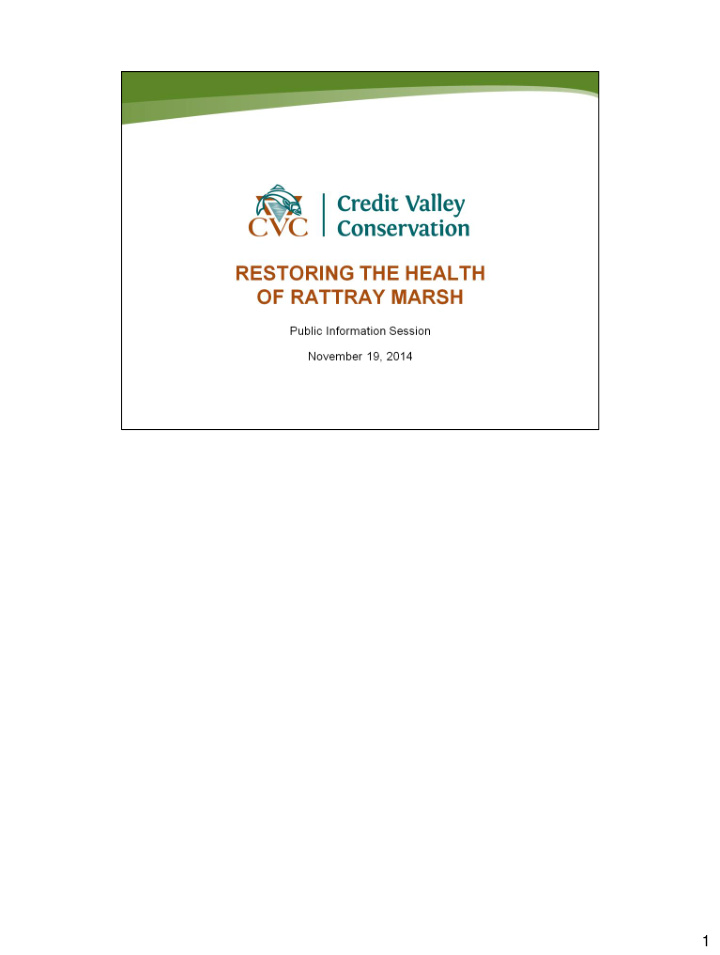



1
14
15
16
Coring to determine peat layer - Sediment testing at …samples taken at two deps 19
20
11/21/2014 - Access alternatives were evaluated. It was determined the least impact to the marsh and conservation area was utilizing an existing access road and construction of temporary access into the marsh to employ conventional dredging techniques for removal of material - First iteration of site plans broke project up into 7 distinct cells so the project could be completed as time and resources allowed Four Alternatives including Do Nothing Preferred Alternative selected by Rattray Marsh Steering Committee Alternative One : Removal of Mineral soils, Management of Invasive Outlet structure to control Carp Alternative Two: Dyke/Levy System to restrict movement of carp from creek and lake Preferred Alternative: Phased removal of mineral soil 21
11/21/2014 First Three Cells. 22
23
Constructed to a width of 9m and height of approximately 1m above grade 1900 tones of stone, 130k project contribution 24
- Prior to beginning any of the sediment removal CVC installs wildlife exclusion fencing around the preimiter of the project boundary. 25
CVC times installation of exclusion fencing with the drawdown of the marsh leaving areas of groundwater discharge open and installs exits doors at strategic locations to allow fish and wildlife out of the project area before marsh is drawn down to mud flat as lake levels recede for the winter. - Active and passive removal of fish and wildlife is also conducted. 26
27
Trapped and tagged 5 and tracked 5 snapping turtles for two seasons to determine preferred over wintering areas for turtles to minimize and potential impacts. 28
29
11/21/2014 - Sediment removal occurs in the winter months when the marsh is frozen and in low water condition. - Frozen conditions helps to support the heavy equipment that is required to conduct the work. - Contractors also utilize the ice and steel plates to construct temporary access roads into the marsh. - Working in the winter also minimizes impacts to sensitive fish and wildlife that use the marsh during the warm weather months. - Phase I project stats Approx 13 days on site Approx 9 Days trucking 154 trucks + 31 trailers for a total of 185 loads taken out. 27 trucks with 6 having trailers was most sediment removed in one day 30
11/21/2014 Trucking and peat 31
32
11/21/2014 - Aquatic plants sourced from Native nursery - Top right shows one season growth – filled in completely 1 square metre - TOP – submergent; Bottom - sedges 33
11/21/2014 - Aquatic plants sourced from Native nursery - Top right shows one season growth – filled in completely 1 square metre - TOP – submergent; Bottom - sedges 34
11/21/2014 With the assistance of Canadian Wildlife Service -Pre restoration Monitoring – 2010 Durham Region Coastal Wetland Monitoring Protocol 2013 – Great lakes Coastal Wetland Monitoring Plan 2014 – Post construction monitoring plan **2010** Durham Region Coastal Wetland Monitoring Protocol 35
11/21/2014 Carp Vandallistm - Monitoring data – visibility 36
EA also recommended carp control as part of the restoration plan CVC 37
EA also recommended carp control as part of the restoration plan CVC 38
11/21/2014 39
11/21/2014 40
11/21/2014 - Shale/Sediment bar continues to form at the mouth of Sheridan Creek, a portion of this bar was orginally slated to be dredged - Revisited this with Geomorphologist and determined that it would continue to function as an area of deposition and any gains obtained from dredgeing would be short lived. - Some of the material deposited here moves out to the lake during high flows. - Also identified in the EA as a desirable area for shorebirds - Helping to naturally isolate the southern basin of the marsh during low water levels. - Phragmites has continued to expand into the southern basin and water level making chemical treatments difficult - Modified site plans to omit areas of continued deposition, preserve stands of cattails not infested prhramites, - Increase depth to dredging to 1-1.5m in highest phragmites density (Cell A) - Approx 6000m3i in total 41
11/21/2014 42
11/21/2014 43
44
Recommend
More recommend